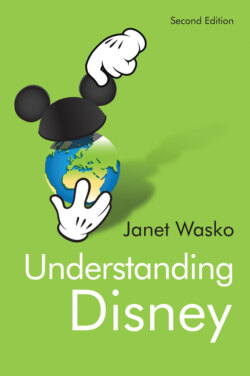Читать книгу Understanding Disney - Janet Wasko - Страница 19
The animation factory
ОглавлениеWith the success of Snow White, the company grew dramatically. By May 1940, the company’s 1,100 employees had moved into a new $3 million studio in Burbank, with 20 separate buildings for the different stages of the animation process. For instance, the Animation and Story departments were separated from the Camera and Inking and Painting buildings, although all were connected via underground tunnels. The new studio represented not only the success of the company but also the growing rationalization of the animation process. While this specialization was intended to make the operation more efficient, it also increased the bureaucracy at the studio.
Other innovations were incorporated into the animation process, including the pencil test (a method of projecting pencil drawings) and the Leica reel (a method of projecting both completed and uncompleted parts of a project). The studio also adapted the storyboard, a series of drawings used to depict an entire film, rather than just segments. Other technological developments included the multi-plane camera, a device that incorporated multiple layers of animation, thus providing increased depth and contributing to Disney’s constant quest for more realism. The famous artists’ school set up at the studio was another innovative feature that helped to eliminate waste, though it also enforced a kind of “uniform technical mastery” among the animators.
Many of these innovations were attributed to Disney, but it is arguable that others at the studio were more responsible for their development. McReynolds noted that Disney had an “unerring appreciation of technical developments and how to use them for profit.”36 As Schickel pointed out, “Disney’s gift, from the beginning, was not as is commonly supposed a ‘genius’ for artistic expression; if he had any genius at all it was for the exploitation of technological innovation.”37
The company received a good deal of publicity for its new studio, which became known as the “fun factory.” People seemed fascinated with the industrial process that created Disney’s films, apparently finding it hard to believe that fantasy could be manufactured. Much less attention, however, was focused on the commercial orientation of Disney’s fantasy production.
Along with the company’s success, its debts had grown as well. So before completing the move to the new Burbank headquarters, the company issued 155,000 shares of preferred stock and 600,000 shares of common stock. Though the company had incorporated in 1929, until now all its stock remained privately held. In 1938, 45,000 shares were owned by Walt and Lillian Disney, and 30,000 shares by Roy and Edna Disney. While the stock sold quickly and provided needed capital for the company, it diluted the Disneys’ ownership control of the company.38 Yet, by most accounts, Walt was still very much in control of the company’s operations, at least until the dramatic events that started unfolding in the early 1940s.
